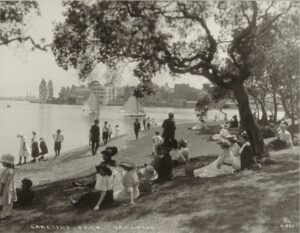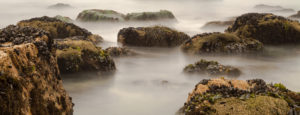Poets have said, more than once, that gazing at a grain of sand can evoke a whole world. Geologists respond that one grain of sand is like one face in a crowd, individual but not very informative. But a tiny pinch of sand has enough grains to tell the story of a whole landscape. To the trained eye, this specimen of coarse beach sand from Point Reyes, magnified 200 times, is a microcosm of northern California’s distinctive shoreline.
Rocks crumble under wind and weather. Once rock particles are reduced to between 1/16 mm and 2 mm in diameter—larger than silt but smaller than gravel—they’re deemed sand. Then rivers grind and water erodes the grains, gradually removing the softer minerals. In this way sand evolves from a youthful complexity to a mature simplicity. The bright colors in the photo signal that this is an immature sand, located near the rocks that gave rise to it.
The consistency of these grains marks the specimen as a beach sand. At beaches the constant ocean waves wash sand back and forth, endlessly milling the grains toward roundness and sifting them by size. Even though some of these grains are young and jagged, while others are more worn and rounded, all are roughly the same size. In geological terms, they are well sorted.
Just from this sand’s appearance, geologists can readily picture a place much like Point Reyes—a coast with strong surf, near sea cliffs bearing a variety of rock types. Most of the California coast has relatively dark, immature sand. But the details in this sample tell us more, showing several types of sand grain derived from specific sources.
The clear and white grains are crystalline quartz, a ubiquitous mineral whose hardness, toughness, and resistance to chemical breakdown make it the king of sand. Only other hard minerals can coexist with quartz for long. The clear, fresh quartz is from granite and the frosted, stained quartz is recycled from sandstone—a rock made of compressed grains from an ancient beach.
The opaque yellowish grains are feldspar, a common mineral found in granites along with quartz. Softer than quartz (it’s the typical mineral in non-scratch cleansers), feldspar is often found in immature sands.
The translucent yellowish grains are chert, a rock derived from the microscopic silica-based skeletons of single-celled marine diatoms. Chert is harder than feldspar (California natives made stone tools of it) and stands up to quartz. Its color ranges from cream through red to black.
The dark grains are mostly chert, colored by whatever organic matter the rock incorporated as it hardened under the ocean floor, but a few of them may be resistant black minerals like magnetite.
The variegated grains are bits of fine-grained granite, still crumbling into separate particles of quartz and feldspar. The presence of these so-called lithic grains is a telltale sign that their source is nearby.
Specialists in forensic geology can study bits of sand from a crime suspect’s shoes or tire treads and determine where it came from, sometimes with uncanny precision. The grains in this sample closely matches the rocks on the northwestern face of the Point Reyes peninsula— where granite outcrops at Tomales Point give way southward to sea cliffs exposing chert of the Monterey Formation (which bleaches with exposure from black to white) and sandstone of the Laird Formation. The abundance of lithic grains and chert points to a location in the northern part of the peninsula.
And what of that single green grain? Note two things about it: It’s rare, and it’s very well rounded. These traits point to a more distant source on the California mainland, east of the San Andreas fault, where the rocks of the Franciscan Complex dominate. The Franciscan’s metamorphic rocks feature green minerals ranging from soft chlorite to gem-quality jade. The color and fabric of this lone straggler best match the mineral actinolite, common in Sonoma County. It was likely washed to the Pacific by the Russian River, then carried south by the prevailing California Current to this Point Reyes beach, joining its cousins from the Pacific plate west of the fault.
Andrew Alden has been writing on geological subjects, from the outer planets to the Bay Area, since 1997. oaklandgeology.wordpress.com





